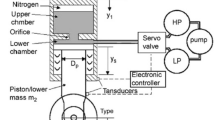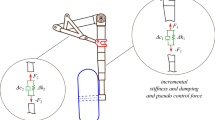Abstract
This study addresses the antivibration issue of a full aircraft active landing gear system (LGS) under landing impact and runway excitations via a novel adaptive observer-based integral event-triggered control method. First, a full aircraft active LGS comprising a front gear and two synchronized main left and right gears with active suspensions is established, where the information exchange among them is not implemented directly. Second, two adaptive observers are designed separately for the front and main LGSs to identify the varying damping parameters and estimate the system states simultaneously. Third, estimated states are transmitted to a shared network through a novel integral event-triggered mechanism (I-ETM); thus, the front and main LGSs are interconnected, and a networked control scheme for the aircraft LGS is constructed. Additionally, the integrated active control law is designed with the aid of the transmitted states of the front and main LGSs, enhancing the robustness against the pitch vibration of the aircraft. Furthermore, the \({\cal L}_{2}\)-stability of the hybrid system is guaranteed to depress the vertical vibration effect of the landing impact and irregular runway excitations, thus improving passenger safety and comfort. Moreover, a codesign method is provided to obtain feasible solutions to the gain matrices of the observers and controllers simultaneously. Simulation and comparison results are presented to illustrate the effectiveness and superiority of the proposed control scheme in antivibration and saving communication resources.
Similar content being viewed by others
References
Howe D. Aircraft Loading and Structural Layout. London: Professional Engineering Publishing, 2004
Ghiringhelli G L, Gualdi S. Evaluation of a landing gear semiactive control system for complete aircraft landing. Aerotecnica Missilie Spazio, 2004, 83: 21–31
Zhang H, Zheng X, Yan H, et al. Codesign of event-triggered and distributed H∞ filtering for active semi-vehicle suspension systems. IEEE ASME Trans Mechatron, 2017, 22: 1047–1058
Zhang H, Hong Q, Yan H, et al. Event-based distributed H∞ filtering networks of 2-DOF quarter-car suspension systems. IEEE Trans Ind Inf, 2016, 13: 312–321
Zapateiro M, Pozo F, Rossell J M, et al. Landing gear suspension control through adaptive backstepping techniques with performance. IFAC Proc Volumes, 2011, 44: 4809–4814
Zhang H, Zheng X, Li H, et al. Active suspension system control with decentralized event-triggered scheme. IEEE Trans Ind Electron, 2020, 67: 10798–10808
Ge X, Ahmad I, Han Q L, et al. Dynamic event-triggered scheduling and control for vehicle active suspension over controller area network. Mech Syst Signal Processing, 2021, 152: 107481
Fei Z, Wang X, Liu M, et al. Reliable control for vehicle active suspension systems under event-triggered scheme with frequency range limitation. IEEE Trans Syst Man Cybern Syst, 2021, 51: 1630–1641
Yoon D S, Kim G W, Choi S B. Response time of magnetorheological dampers to current inputs in a semi-active suspension system: Modeling, control and sensitivity analysis. Mech Syst Signal Processing, 2021, 146: 106999
Wu Y, Ren G-P, Zhang H-T. Dual-mode predictive control of a rotor suspension system. Sci China Inf Sci, 2020, 63: 112204
Wen S, Chen M Z Q, Zeng Z, et al. Fuzzy control for uncertain vehicle active suspension systems via dynamic sliding-mode approach. IEEE Trans Syst Man Cybern Syst, 2016, 47: 24–32
Liu L, Li X, Liu Y J, et al. Neural network based adaptive event trigger control for a class of electromagnetic suspension systems. Control Eng Pract, 2021, 106: 104675
Gharapurkar A A, Jahromi A F, Bhat R B, et al. Semi-active control of aircraft landing gear system using H-infinity control approach. In: Proceedings of International Conference on Connected Vehicles and Expo (ICCVE), 2013. 679–686
Wang H, Xing J T, Price W G, et al. An investigation of an active landing gear system to reduce aircraft vibrations caused by landing impacts and runway excitations. J Sound Vib, 2008, 317: 50–66
Sivakumar S, Haran A P. Mathematical model and vibration analysis of aircraft with active landing gears. J Vib Control, 2015, 21: 229–245
Suresh P S, Sura N K, Shankar K. Investigation of nonlinear landing gear behavior and dynamic responses on high performance aircraft. J Aerospace Eng, 2019, 233: 5674–5688
Yazici H, Sever M. Observer based optimal vibration control of a full aircraft system having active landing gears and biodynamic pilot model. Shock Vib, 2016, 2016: 1–20
Chen Z Y, Han Q-L, Yan Y M, et al. How often should one update control and estimation: review of networked triggering techniques. Sci China Inf Sci, 2020, 63: 150201
Zhu S Y, Liu Y, Lou Y J, et al. Stabilization of logical control networks: an event-triggered control approach. Sci China Inf Sci, 2020, 63: 112203
Yu H, Hao F, Chen T. A uniform analysis on input-to-state stability of decentralized event-triggered control systems. IEEE Trans Automat Contr, 2019, 64: 3423–3430
Dolk V S, Borgers D P, Heemels W P M H. Output-based and decentralized dynamic event-triggered control with guaranteed \({\cal L}_{p}\)-gain performance and zeno-freeness. IEEE Trans Automat Contr, 2017, 62: 34–49
Tabuada P. Event-triggered real-time scheduling of stabilizing control tasks. IEEE Trans Automat Contr, 2007, 52: 1680–1685
Heemels W P M H, Teel A R, van de Wouw N, et al. Networked control systems with communication constraints: tradeoffs between transmission intervals, delays and performance. IEEE Trans Automat Contr, 2010, 55: 1781–1796
Carnevale D, Teel A R, Nesic D. A Lyapunov proof of an improved maximum allowable transfer interval for networked control systems. IEEE Trans Automat Contr, 2007, 52: 892–897
Zhang Y F, Wu Z-G, Wu Z Z, et al. Resilient observer-based event-triggered control for cyber-physical systems under asynchronous denial-of-service attacks. Sci China Inf Sci, 2022, 65: 142203
Ma H, Li H Y, Lu R Q, et al. Adaptive event-triggered control for a class of nonlinear systems with periodic disturbances. Sci China Inf Sci, 2020, 63: 150212
Li H, Zhang Z, Yan H, et al. Adaptive event-triggered fuzzy control for uncertain active suspension systems. IEEE Trans Cybern, 2019, 49: 4388–4397
Wang X, Lemmon M D. Event design in event-triggered feedback control systems. In: Proceedings of the 47th IEEE Conference on Decision and Control, 2008. 2105–2110
Wang X, Lemmon M. On event design in event-triggered feedback systems. Automatica, 2011, 47: 2319–2322
Girard A. Dynamic triggering mechanisms for event-triggered control. IEEE Trans Automat Contr, 2015, 60: 1992–1997
Mousavi S H, Ghodrat M, Marquez H J. Integral-based event-triggered control scheme for a general class of non-linear systems. IET Control Theor & Appl, 2015, 9: 1982–1988
Mousavi S H, Ghodrat M, Marquez H J. A novel integral-based event triggering control for linear time-invariant systems. In: Proceedings of the 53rd IEEE Conference on Decision and Control, 2014. 1239–1243
Du C, Shi Y, Li F, et al. An improved co-design method of dynamical controller and asynchronous integral-type event-triggered mechanisms. IEEE Trans Syst Man Cybern Syst, 2023, 53: 2500–2509
Du C, Li F, Shi Y, et al. Integral event-triggered attack-resilient control of aircraft-on-ground synergistic turning system with uncertain tire cornering stiffness. IEEE CAA J Autom Sin, 2023, 10: 1276–1287
Mnih V, Kavukcuoglu K, Silver D, et al. Human-level control through deep reinforcement learning. Nature, 2015, 518: 529–533
Sutton R S, Barto A G. Reinforcement Learning: An Introduction. Cambridge: MIT Press, 2018
Acknowledgements
This work was supported by National Natural Science Foundation of China (Grant Nos. 62303492, 61973319), National Science Fund for Excellent Young Scholars of China (Grant No. 62222317), Postdoctoral Fellowship Program of CPSF (Grant Nos. BX20230430, 2023M733940), Science and Technology Major Project of Hunan Province (Grant No. 2021GK1030), Key R&D Plan of Hunan Province (Grant No. 2023GK2023), Science and Technology Innovation Program of Hunan Province (Grant No. 2022WZ1001), Natural Science Foundation of Hunan Province (Grant No. 2023JJ40765), and Natural Science Foundation of Changsha (Grant No. kq2208287).
Author information
Authors and Affiliations
Corresponding author
Rights and permissions
About this article
Cite this article
Hu, W., Du, C., Li, F. et al. Adaptive observer-based integral event-triggered antivibration control of a full aircraft active landing gear system with irregular runway excitations. Sci. China Inf. Sci. 67, 162201 (2024). https://doi.org/10.1007/s11432-023-3923-8
Received:
Revised:
Accepted:
Published:
DOI: https://doi.org/10.1007/s11432-023-3923-8




